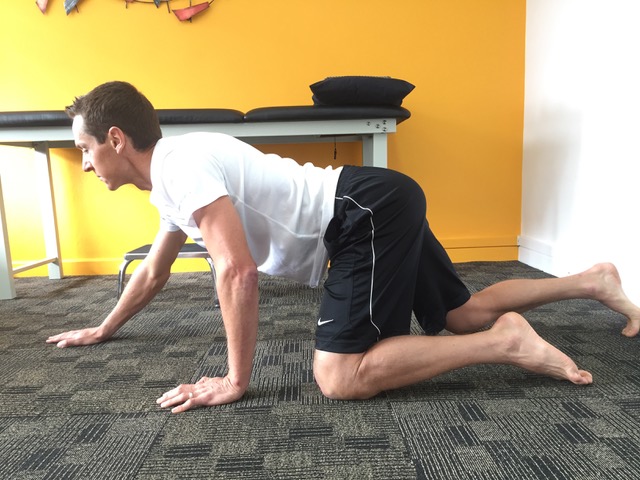Carving out 5- 10 minutes each day for deliberate mobility practice can absolutely help reprogram body movement patterns, muscle and nerve tension. Mobility helps to change body postures and positions, especially those that we get stuck in too easily throughout each and every day.
These 4 mobilising drills are a great step in changing a posterior pelvic tilt pattern. I’d recommend that mobilising is a prerequisite to stretching/rolling or even strengthening. Mobilising, when done correctly begins to incorporate positive aspects of lengthening and strengthening simultaneously throughout the necessary parts of your spine and hips. Aim for 30 – 60 second efforts of each movement. Please however, remember that doing more does not equal better.
First move well then, and as good movement becomes habit, then move often…..
1.1 Crawling (0:24)
Simple yet so effective. Yes it is precursor to walking. Even though many of us have appeared to master walking, going back to the basics can help develop the correct neural patterns and muscle memory that can strengthen the core & enhance our overall posture. For more of crawling check out https://originalstrength.net/
Also “exercise” is allowed to be fun! Crawling is a great way to bring an element of play into a routines so don’t worry about being perfect, have fun and vary the movement up. Crawl like a baby, bear, lizard, sideways, backwards, etc. Crawling is a great movement pattern that we can all benefit from.
1.2 Rocking (1:10)
Another great “reset” exercise as described by the guys from https://originalstrength.net/. This can be as simple as getting into an “all fours” position and while keeping the torso long & arms outstretched, rocking your body back as far as possible towards your heels or calves.
The lubrication this provides the lower back and hips makes it a fantastic warm up for any exercise session and it helps to break the muscle restriction from hours of sitting or hunching.
1.3 Lunges (1:48)
If we are to change our posture, it is important to do so in a weight bearing position. With lunges we do this in a strong upright position trying to stay as upright as possible throughout. When it comes to a posterior pelvic tilt, stepping forwards into a lunge is going to be more beneficial than stepping backwards.
Lower the rear knee towards the ground focusing more on stability and keeping tall, not collapsing your chest towards the front leg and similarly don’t feel your bent knee has to touch the ground if that is going to make you wobble and fall.
Upright posture here is the key- possibly try this with hands on your waist, chest out proud or even better, with both hands interlocked on top of your head.
1.4 Seals (2:45)
This is the final of our mobility sequence and Seals is a move I first learnt through ZUU & the guys at Up & Adam Performance training. It can be tough to so please make sure you are comfortable with the crawling, rocking and lunges before stepping up to seals.
Lower yourself into the lowest possible plank position with hands directly under your shoulders, then keeping your chest towards the floor, kick one of your feet up behind you, bending and twisting that same leg so that it touches the ground on the other side of the still straight leg. Bring it back to neutral then kick the opposite leg back in the alternate direction. This does a lot for opening our hips and reducing psoas tension while in the same breath needs strength and muscle coordination to be done right.
Feel confident with these mobilising drills? Go to Part 2 here.

